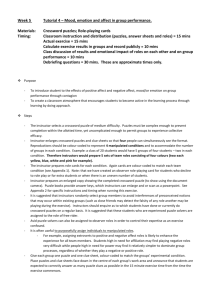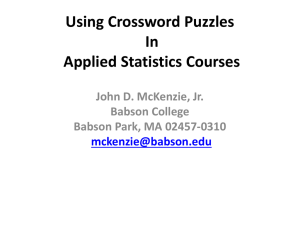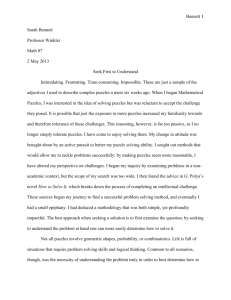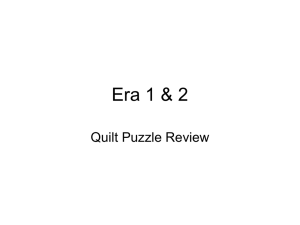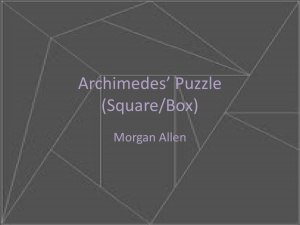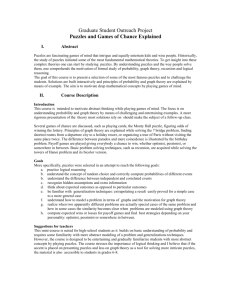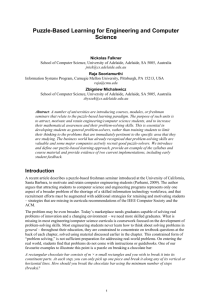Embedding Puzzle-based Learning in STEM
advertisement
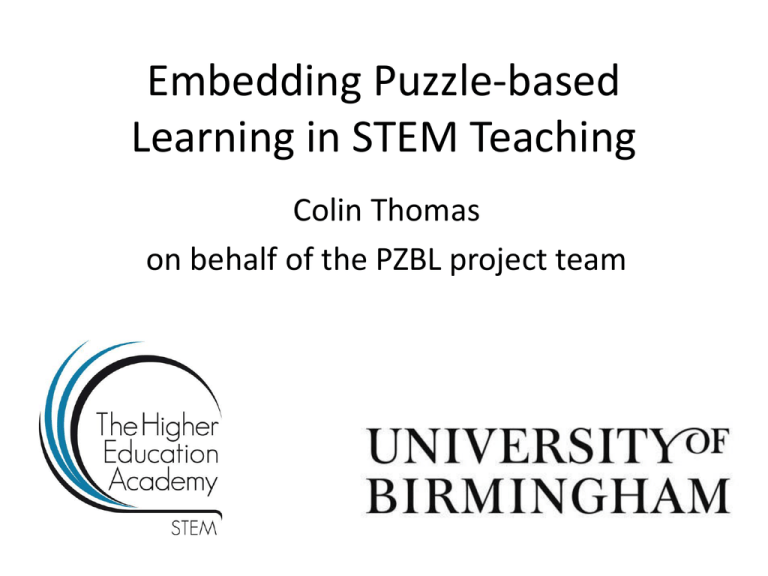
Embedding Puzzle-based Learning in STEM Teaching Colin Thomas on behalf of the PZBL project team Aims of Meeting • Dissemination and discussion of our ideas on Puzzle-based Learning • Help with making the draft Guide more useful, especially with respect to specific STEM subjects • Help you use puzzles in your teaching • Have fun Overview of Meeting 11:00 to 11:30 am 11:30 am to 12:30 pm 12:30 pm to 1:30 pm 1:30 pm to 2:30 pm 2:30 pm to 3:30 pm 3:30 pm Puzzle-solving warm-up Plenary and discussion Lunch Group work preparing STEM specific variants Reporting back Refreshments and close Acknowledgements Initial funding: Centre for Learning and Academic Development, UoB Meeting funding: Higher Education Academy Matthew Badger: collected puzzles Chris Sangwin: drafted first version of Guide Esther Ventura-Medina Colin Thomas .. and many puzzle setters and solvers over several millennia! Project Aim To develop new learning resources to enable staff working in STEM to incorporate puzzle-based learning in their teaching We believe embedding puzzles will • develop students’ general problem-solving skills • develop group working and independent learning skills • increase students’ motivation to learn mathematics Puzzle-based Learning (PzBL) • long tradition in mathematics • Michalewicz and Michalewicz (2008) book: Puzzle-based Learning: Introduction to critical thinking, mathematics, and problem solving • courses at the University of Adelaide • we wanted to embed PzBL in our modules What is a Puzzle? Initial thoughts • task: any activity given to a student • (mathematical) exercise: a task that can be solved by a routine, well-established technique – often part of direct instruction and traditional teaching involving drill and imitation – usually relates closely to what has just been taught • problem: more than an exercise – often posed in words, especially in Engineering A large steel cylindrical tank is required to have a volume of 32 m3 and to use the smallest amount of steel in its construction. What height will it have to be to satisfy these conditions? – needs the student to decide how to proceed, undressing the task and isolating the essentials • experience of problem solving can make problems less challenging needs thinking Writing down equations from word problems can pose some serious difficulties For example: Write an equation for the following statement: “There are six times as many students as professors at this university”. Clement et al. (1981): of 150 calculus level students, 37% answered incorrectly and 6S = P accounted for two thirds of the errors Fermi Problems Require estimation and approximation - useful skill for all STEM students e.g. to check answers to Engineering design problems - orders of magnitude What is a Puzzle? • Michalewicz and Michalewicz (2008) Four criteria for a puzzle: – generality – simplicity – “Eureka” factor – entertainment factor What is a Puzzle? A puzzle is a problem that is perplexing and can only be solved by applying considerable ingenuity ? Solving the puzzle usually results in a “Eureka” moment and the process of finding a solution is both frustrating and entertaining We contend that a puzzle should contain all the information needed for its solution e.g. Two squares intersect as shown in the diagram. The smaller square has side length 30 cm, the larger 40 cm, and the top left corner of the larger square sits at the centre of the smaller. Find the area of the intersection of the two squares. The angle is not given so we can infer it does not matter: Can a problem with no solution be a valid puzzle? Below is part of an infinite integer lattice. A lattice triangle is a triangle where the coordinates of all vertices are integers. • • • • • • • • • • • • • • • • • • • • • • • • • • • • • • • • • • • • • • • • • • • • • • • • • • • • • • • • • • • • • • • • • • • • • • • • • • • • • • • • • • • • • • • • • • • • • • • • What is the size of the smallest equilateral lattice triangle? Puzzles for embedding • We sought puzzles that had both a conventional and a lateral thinking solution – much harder than one might think – can provide great pedagogic value Two segments are drawn as diagonals on the sides of a cube so that they meet at a vertex of the cube. What is the angle between the segments? This was set in a class on vectors. Vectors were therefore used to get the answer (60°)! The red triangle is equilateral so the angle is 60° Messages: Think first! If an answer is simpler than one might expect, why? Variants Perhaps we should make our puzzles subject specific e.g. As part of her plant layout, as shown in Figure 1, a chemical engineer has a pipe going from point A on a cubical tank up to point B, and then across to point C. What angle does the pipe have to be bent to fit the tank? As part of his latest engine block design shown in Figure 1, a mechanical engineer has a pipe going from point A in his cubical block up to point B, and then across to point C. What angle does the pipe have to be bent to fit the block? How not to do variants? “Each day,” said the demanding boss to the metallurgist, “you must fill some casting moulds with molten titanium, and you will continue to do this until all the moulds are full. Moreover, each day your work will become more strenuous. On each day after the first, you must fill double the number of moulds that you have so far filled. For example, if you fill 3 moulds with titanium on the first day, you will fill 6 on the second, 18 on the third and so on. Clear?” “Perfectly clear,” said the metallurgist who summoned his team and with great skill and dedication, the moulds began to fill. After a week, a third of the available moulds were full. How long did it take them to do the job? Prove this mathematically. Another reason not to do variants? Alice and Bob take two hours to dig a hole. Bob and Chris take three hours to dig the hole, while Chris and Alice would take four hours. How long would they take working together? There are three construction companies: AcMe, BeMe and CeMe. Working together, AcMe and BeMe take two days to erect a building. BeMe and CeMe would take three days to build a similar building whilst AcMe and CeMe would take four days. How long would AcMe, BeMe and CeMe take working together? Surprising, but not a puzzle? A railway track is exactly 1 km long. It sits on a piece of ground that is flat. One day, under intense heat from the sun, the track expands 1 m in length. Its ends remain fixed to the ground, so the track bows up to form a circular arc of length 1001 m. At the centre of the arc, how high is the track above the ground? What is the educational value of problems? • • • • • In solving problems a student needs to take personal responsibility make choices develop modelling skills develop tenacity practice recognition of cases, reducing problem situations to exercises What is the educational value of puzzles? We contend that puzzles can provide • additional challenges • additional insights • entertainment all of which can increase student engagement and promote independent learning • Puzzle-based Learning is a subset of • Problem-based Learning is a subset of • Enquiry-based Learning Puzzling in practice • Modelling Concepts and Tools • The Moore Method Originally the puzzles were bolted on, now they are embedded e.g. Alice and Bob take two hours to dig a hole. Bob and Chris take three hours to dig the hole, while Chris and Alice would take four hours. How long would they take working together? The Moore Method Chris Sangwin What are the differences between a problem and a puzzle? Should a puzzle contain all the information needed for its solution? Can a problem with no solution be a puzzle? Is surprise enough to make a puzzle? Should puzzles be embedded or taught in stand alone modules or either? Are the most useful puzzles those with lateral solutions? How important is it to have subject specific variants? Aim of Group Work • To prepare as many subject-specific variants to puzzles as possible • To present one variant to the meeting for discussion • To identify any issues there might be in embedding puzzles in STEM teaching

